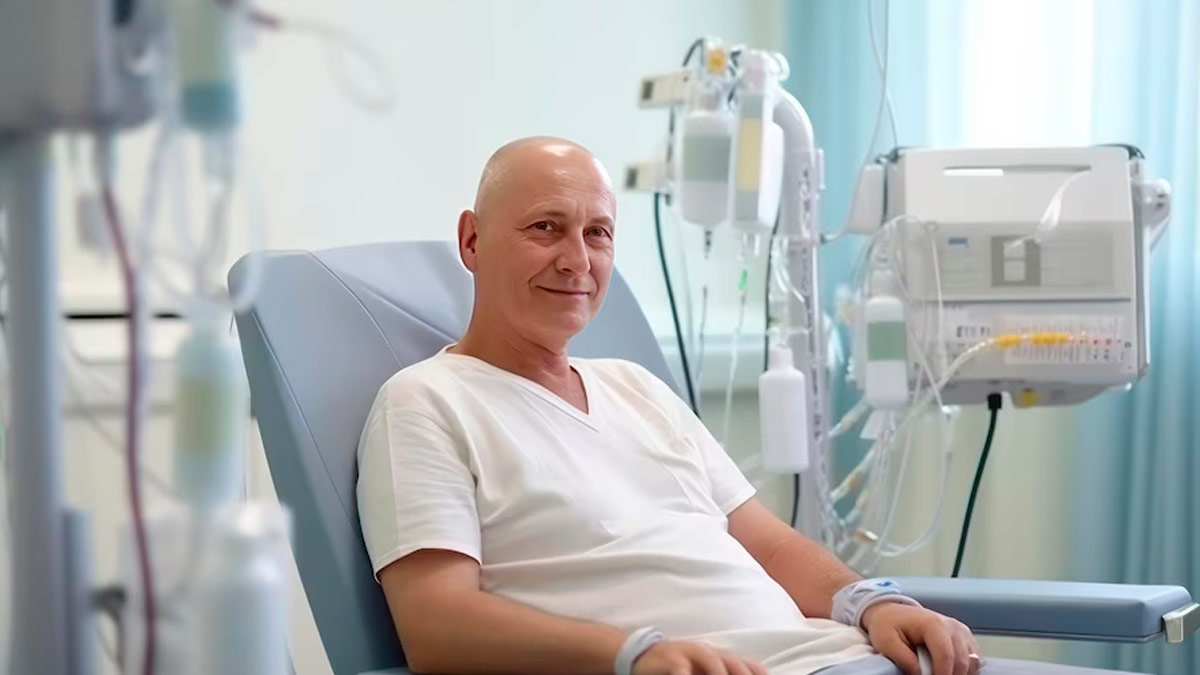
Chemotherapy, a cornerstone of cancer treatment, often evokes fear and uncertainty. However, understanding the process can help patients to navigate this journey with greater confidence. Chemotherapy is a common cancer treatment that can be given in various forms, such as injections or tablets, and is used to treat cancer either before or after surgery. We spoke to our expert Dr Pritam Kataria, Medical Oncology, Sir HN Reliance Foundation Hospital, Mumbai, who explained this chemotherapy treatment, its process, and what to expect.
Table of Content:-
What Is Chemotherapy?

“Chemotherapy is a common treatment for cancer and is part of systemic therapy. Cancer treatment can be divided into three types: surgery, radiation therapy, and systemic therapy. Systemic therapy includes chemotherapy, targeted therapy, immunotherapy, and hormonal therapy,” said Dr Kataria.
Chemotherapy can be given in injectable or tablet form and is used in both curative and palliative treatments. It can be administered either before or after surgery. According to StatPearls, chemotherapy aims to stop the spread and growth of cancer cells, preventing them from invading other body parts. However, it can also impact normal cells, causing side effects. Chemotherapy targets various levels within the cell and its environment to inhibit tumour growth.
Types of Chemotherapy Administration
.jpg)
“Injectable or intravenous chemotherapy can be administered through the hand, known as an intracath or specialised access devices like a port or PICC (Peripherally Inserted Central Catheters) line. Some chemotherapy drugs can cause injury to the vein and surrounding soft tissue, leading to conditions, such as thrombophlebitis and extravasation injury,” said Dr Kataria.
This may lead to pain, swelling, and in more severe instances, tissue breakdown and tendon injury, which might require a plastic surgeon’s intervention. Therefore, it’s advisable to discuss the use of a port or PICC line with your treating physician.
Preparing for Chemotherapy

Before Chemotherapy
“Before starting chemotherapy, the physician will advise routine blood tests and urine reports. Special tests like 2D echo (echocardiogram) and ECG may be necessary based on the drug being administered. For example, if Adriamycin is planned, a 2D echo is important as this drug can affect heart function. Ensure these tests are completed for patient safety,” explained Dr Kataria.
Before going to chemotherapy, make sure to have a good breakfast or meal; there's no need to fast. During the session, feel free to eat and drink water to stay hydrated. You can relax, sit down, and even use your mobile phone while undergoing chemotherapy.
After Chemotherapy
After chemotherapy, ensure that the intracath or port/PICC line is properly removed. Make sure you are clear about all the medications you need to take, especially those to prevent nausea and vomiting. In some cases, you may need a subcutaneous injection 24 hours after chemotherapy to maintain your White Blood Cell (WBC) count, which can be administered at home.
“After going home, there are no dietary restrictions except that food should be freshly prepared. All kinds of fruits can be consumed after proper washing. Light exercises or morning walks are encouraged based on individual capability. Avoid crowded places due to the risk of infection,” highlighted Dr Kataria.
Also Read: Dancing Through Chemotherapy: Kathak Artist’s Battle with Ovarian Cancer
Possible Side Effects Of Chemotherapy
After chemotherapy, you may experience the following side effects:

- Fatigue or tiredness
- Loss of taste or reduced appetite
- Nausea or vomiting
- Hair loss
- Mouth sores
- Loose motions
- Rashes
- Fever
Fatigue and taste disturbances are common side effects of chemotherapy but often improve over time. However, for other symptoms, contact the treating physician for guidance on countermeasures. The doctor may schedule a follow-up after one week, especially after the first chemotherapy, to assess tolerance and make necessary dose adjustments. Blood tests may be required after one week to check blood counts.
Subsequent Cycles
Before each chemotherapy cycle, routine blood tests, including a complete blood profile as well as liver and kidney function tests, are required. The physician will review any difficulties during the previous cycle and take necessary actions. “For instance, if vomiting occurs, additional medications might be added for the next cycle. Maintain a diary to note any problems faced so that preventive measures can be considered,” said Dr Kataria.
Monitoring and Assessments
Physical assessments and periodic investigations like CT scans, PET-CT scans, 2D echo, and ECGs may be conducted regularly. With new drugs and a better understanding of chemotherapy side effects, the severity of side effects has decreased significantly.
Maintaining a Positive Attitude
Dr Kataria highlighted, “Maintaining a positive attitude is crucial during chemotherapy. It is a challenging journey, and addressing social and cultural aspects with the treating physician or counsellors can help overcome fears and stress. Mood changes and psychological disturbances due to stress or certain drugs, like steroids, may occur. Hormonal changes and stress can lead to anxiety and adjustment issues, which should be discussed with doctors or counsellors.”
[Disclaimer: This article contains information provided by an expert and is for informational purposes only. Hence, we advise you to consult your own professional if you are dealing with any health issues to avoid complications.]
Also watch this video
How we keep this article up to date:
We work with experts and keep a close eye on the latest in health and wellness. Whenever there is a new research or helpful information, we update our articles with accurate and useful advice.
Current Version